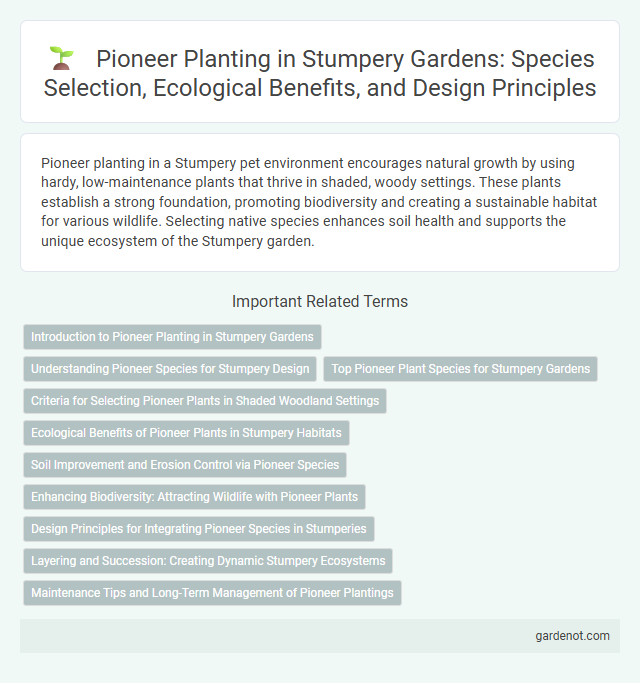Pioneer planting in a Stumpery pet environment encourages natural growth by using hardy, low-maintenance plants that thrive in shaded, woody settings. These plants establish a strong foundation, promoting biodiversity and creating a sustainable habitat for various wildlife. Selecting native species enhances soil health and supports the unique ecosystem of the Stumpery garden.
Introduction to Pioneer Planting in Stumpery Gardens
Pioneer planting in stumpery gardens involves selecting hardy, low-maintenance plants that thrive in shaded, damp environments created by decaying wood structures. Ferns, mosses, lichens, and shade-tolerant wildflowers establish quickly, promoting biodiversity and soil health within the stumpery ecosystem. This early vegetation supports natural succession by enhancing moisture retention and providing habitat for invertebrates essential to the garden's ecological balance.
Understanding Pioneer Species for Stumpery Design
Pioneer species play a crucial role in stumpery design by initiating soil stabilization and creating microhabitats that support subsequent plant growth. These hardy plants, such as ferns, mosses, and lichens, thrive in disturbed environments and enhance biodiversity by attracting insects and small fauna. Incorporating pioneer species into a stumpery ensures sustainable ecosystem development and long-term garden resilience.
Top Pioneer Plant Species for Stumpery Gardens
Top pioneer plant species for stumpery gardens include ferns like Dryopteris filix-mas and Polystichum setiferum, which thrive in shaded, damp environments typical of stumpery settings. Hardy moss species such as Hypnum cupressiforme quickly colonize decaying wood, promoting ecological succession and enhancing texture. Early colonizers like primroses (Primula vulgaris) and wood anemones (Anemone nemorosa) add seasonal color while stabilizing soil around the timber structures.
Criteria for Selecting Pioneer Plants in Shaded Woodland Settings
Pioneer plants in shaded woodland settings must exhibit shade tolerance, rapid establishment, and strong root systems to stabilize soil and enhance microhabitats. Species such as ferns, mosses, and shade-adapted shrubs thrive by efficiently utilizing limited light and influencing soil moisture retention. Selecting native, low-maintenance pioneers that support local biodiversity ensures a successful stumpery ecosystem foundation.
Ecological Benefits of Pioneer Plants in Stumpery Habitats
Pioneer plants in stumpery habitats stabilize soil by preventing erosion and enhancing nutrient cycling through root activity and organic matter decomposition. These early colonizers improve habitat complexity, fostering biodiversity by providing shelter and food sources for insects, fungi, and small vertebrates. Their rapid growth and adaptability accelerate ecological succession, creating favorable conditions for later plant species and promoting resilient, self-sustaining ecosystems.
Soil Improvement and Erosion Control via Pioneer Species
Pioneer planting in stumperies involves using hardy pioneer species like ferns and mosses to enhance soil quality by fixing nitrogen, increasing organic matter, and improving moisture retention. These species stabilize the soil surface, effectively reducing erosion on disturbed or degraded sites within shaded woodland environments. Their early establishment creates favorable conditions for subsequent plant succession, ensuring long-term ecosystem resilience and soil health.
Enhancing Biodiversity: Attracting Wildlife with Pioneer Plants
Pioneer planting in stumperies enhances biodiversity by introducing hardy pioneer plants that create a habitat for diverse wildlife, including insects, birds, and small mammals. These plants improve soil quality and microclimate conditions, facilitating the establishment of more complex plant communities over time. Attracting pollinators and beneficial insects through pioneer species supports ecological balance and promotes a thriving, sustainable garden ecosystem.
Design Principles for Integrating Pioneer Species in Stumperies
Pioneer planting in stumperies emphasizes the use of hardy pioneer species such as birch, alder, and willow to establish early structural layers and improve soil conditions. Design principles focus on integrating these species in clusters to enhance biodiversity, facilitate natural succession, and create microhabitats for shade-loving plants like ferns and mosses. Strategic placement ensures pioneer species do not overshadow slower-growing plants, promoting a balanced ecosystem within the stumpery.
Layering and Succession: Creating Dynamic Stumpery Ecosystems
Pioneer planting in stumperies utilizes layering and succession to establish dynamic ecosystems that mimic natural forest regeneration processes. By selecting shade-tolerant ferns, mosses, and native understory plants, layers develop from ground cover to mid-height, promoting biodiversity and soil stability. Successional planting ensures continuous growth stages, enhancing habitat complexity and resilience over time.
Maintenance Tips and Long-Term Management of Pioneer Plantings
Pioneer plantings require regular monitoring to control invasive species and ensure soil stability, promoting healthy ecosystem development. Mulching around young plants retains moisture and suppresses weeds, reducing competition and enhancing growth. Long-term management includes periodic assessment of plant diversity and structural integrity to support succession and habitat restoration.
Pioneer planting Infographic

 gardenot.com
gardenot.com